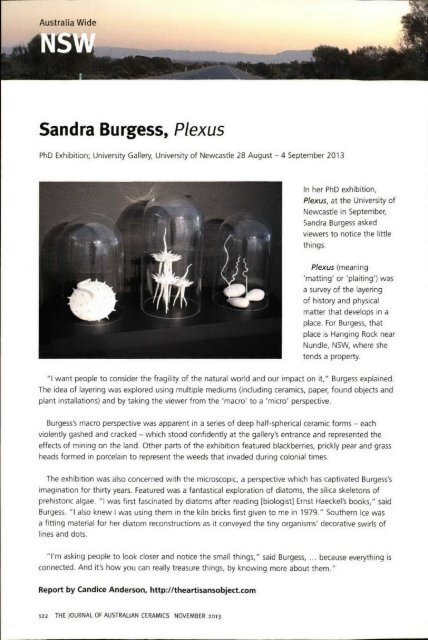The Journal of Australian Ceramics Vol 52 No 3 November 2013
You also want an ePaper? Increase the reach of your titles
YUMPU automatically turns print PDFs into web optimized ePapers that Google loves.
Sandra Burgess, Plexus<br />
PhD Exhibition; University Gallery, University <strong>of</strong> Newcastle 28 August - 4 September <strong>2013</strong><br />
In her PhD exhibition,<br />
Plexus, at the University <strong>of</strong><br />
Newcastle in September,<br />
Sandra Burgess asked<br />
viewers to notice the little<br />
things.<br />
Plexus (meaning<br />
'matting' or 'plaiting') was<br />
a survey <strong>of</strong> the layering<br />
<strong>of</strong> history and physical<br />
matter that develops in a<br />
place. For Burgess, that<br />
place is Hanging Rock near<br />
Nundle, NSW, where she<br />
tends a property.<br />
"I want people to consider the fragility <strong>of</strong> the natural world and our impact on it," Burgess explained.<br />
<strong>The</strong> idea <strong>of</strong> layering was explored using multiple mediums (including ceramics, paper, found objects and<br />
plant installations) and by taking the viewer from the 'macro' to a 'micro' perspective.<br />
Burgess's macro perspective was apparent in a series <strong>of</strong> deep half-spherical ceramic forms - each<br />
violently gashed and cracked - which stood confidently at the gallery's entrance and represented the<br />
effects <strong>of</strong> mining on the land. Other parts <strong>of</strong> the exhibition featured blackberries, prickly pear and grass<br />
heads formed in porcelain to represent the weeds that invaded during colonial times.<br />
<strong>The</strong> exhibition was also concerned with the microscopic, a perspective which has captivated Burgess's<br />
imagination for thirty years. Featured was a fantastical exploration <strong>of</strong> diatoms, the silica skeletons <strong>of</strong><br />
prehistoric algae. "I was first fascinated by diatoms after reading {biologistj Ernst Haeckel's books," said<br />
Burgess. "I also knew I was using them in the kiln bricks first given to me in 1979." Southern Ice was<br />
a fitting material for her diatom reconstructions as it conveyed the tiny organisms' decorative swirls <strong>of</strong><br />
lines and dots.<br />
''I'm asking people to look closer and notice the small things," said Burgess, ... because everything is<br />
connected. And it's how you can really treasure things, by knowing more about them."<br />
Report by Candice Anderson. http://theartisansobject.com<br />
122 THE JOURNAL OF AUSTRALIAN CERAMICS NOVEMBER <strong>2013</strong>

















